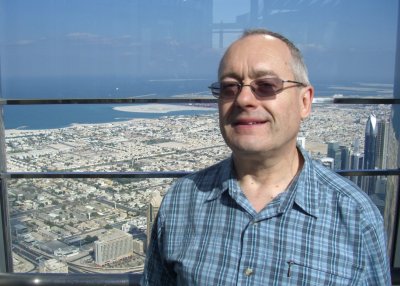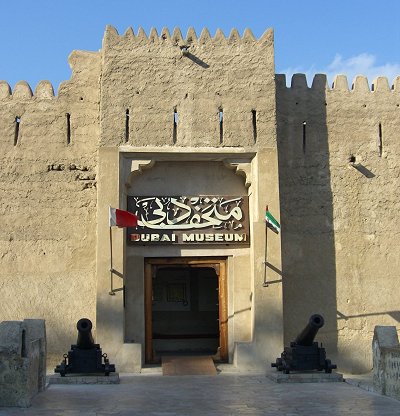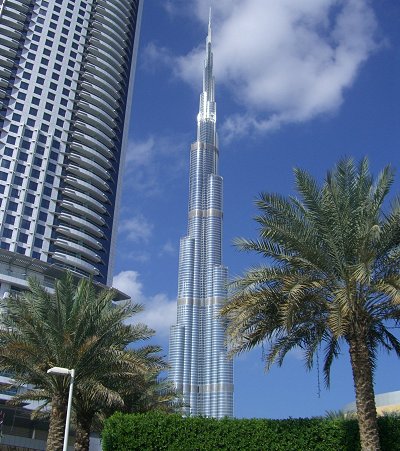My Travel Blog - 2011
| Date | Place |
| November 2011 | Dubai, UNITED ARAB EMIRATES |
| November 2011 | Vittorio Veneto, ITALY |
| September 2011 | Ostend, Bruges and Brussels, BELGIUM |
| June 2011 | Łódź, POLAND |
| May 2011 | Washington and Gettysburg, UNITED STATES |
| April 2011 | Kavala, GREECE |
November 2011 - Dubai, UNITED ARAB EMIRATES
I had a stopover in Dubai just enough time to visit some tourist sites including the 'At The Top' Observation Deck in the Burj Khalifa. It is best to book your ticket for the Observation Deck in advance from the website to save disappointment if you have only limited time in Dubai.
Jumeirah Mosque
Al Fahidi Fort
Burj Khalifa is currently the worlds tallest building
Looking down on Burj Khalifa lake from the Observation Deck
View over Dubai from the Observation Deck

Souk Al Bahar is located on an island in the Burj Khalifa lake
Sophisticated irrigation systems allow plants to survive in Dubai
November 2011 - Vittorio Veneto, ITALY
Vittorio Veneto is a small city located on the border between the Venetian plains and the mountains. The city was formed from the union of the towns of Ceneda and Serravalle in 1866. I had the chance to explore the old town centre of Serravalle during a recent visit to the area.
Piazza Flaminio the central square of the old town of
Serravalle is paved with stone slabs from Istria in Croatia
The Comunità Lodge (built 1462-1476)
or town hall now houses a museum
The highly decorated facade of the Comunità Lodge
has the winged lion symbol of the Venetian Republic
The river Meschio passes down through Serravalle
(the river wall is braced as a flood defence mechanism)
Steps and a long winding path lead to the Sanctuary of
St. Augusta situated on a hill overlooking Vittorio Veneto
The path is quite steep and you pass seven
small chapels on the way to the Sanctuary
A tower not far from the Sanctuary of St. Augusta
A colony of cats lives by the tower
You get a good view from the top of the hill
Coming back by a different route I paused to look up
at the church on the hill dedicated to St. Augusta
September 2011 - Ostend, Bruges and Brussels, BELGIUM
I am on holiday in Belgium staying in Ostend. Currently there is a lot of building work being carried out on the seafront with the construction of two new breakwaters to make the harbour of Ostend accessible to larger container ships and to protect the city against flooding. Historically Ostend was a strategically important port and the remains of defence structures built by invading armies are still evident on the outskirts of Ostend today.
View of Ostend from the pier
Claiming to be the oldest house in Ostend the
Spanish Inn is located at Kapucijnenstraat 42
The live music starts at 9.30 p.m.
Part of the Atlantic Wall constructed by the Germans during the Second World War has been preserved as an open-air museum just south of Ostend. You can get there by taking the coastal tram from the centre of Ostend to Domein Raversijde. After getting off the tram cross the main road and you will find a path through the sand dunes. At the end of the path turn left and it is only a 5 minute walk down the road to the museum. Here you will find bunkers interconnected by a series of trenches and tunnels dating from both World Wars. Fortifications from the First World War were utilised and expanded in the construction of the Atlantic Wall. In reality the Atlantic Wall was not a continuous structure like Hadrian's Wall or the Great Wall of China but consisted of a chain of fortified strong points.
The PAK 36 a 37 mm anti-tank gun had become obsolete
by 1944 however it could still pack a punch when armed
with more recently developed hollow-charge grenades
The 75 mm PAK 40 is a more formidable anti-tank gun
Captured artillery pieces such as this 120 mm Belgian field gun
were used to bolster the defences of the Atlantic Wall
The FLAK 28 is a 40 mm anti-aircraft gun
Trench constructed during the First World War
to conceal troop movements
Soldiers of the German Naval Corps constructed the First World
War defences and are depicted here in a bomb proof shelter
Tunnel with escape hatch dating back to the Second World War
Depiction of German soldiers during the Second World War
Constructed between 1810 and 1814 Fort Napoleon lies to the north of Ostend. It is just two stops by tram from Ostend railway station and well worth a visit as it is the only intact fortress of this type remaining from the Napoleonic era.
Welcome to Fort Napoleon
Fort Napoleon doesn't look that impressive from a distance
A killing zone was created between the outer and inner walls
The view of Ostend from the top of Fort Napoleon
Looking down into the courtyard. The windows were
designed to allow maximum light into the fortress.
Bruges (the Flemish name is Brugge) is almost completely ringed by parkland sited on the remains of the earthwork bastions constructed to defend the city centuries ago. The well preserved historical centre with its system of canals and many examples of medieval architecture is reasonably compact and quite easy to walk round.
The Minnnewater is a natural broadening of the river Reie
used as a reservoir to control the water level in the canals
The Sashuis (sluice house) houses the gates used
to regulate the water levels in the canals
Swans are a common sight on the canals
Entrance gate to the Béguinage of Bruges which
is now a monastery for the Benedictine sisters
Inside the Béguinage where béguines
(members of a sisterhood) used to live
The Half Moon family brewery
Horse drawn carriage rides are popular
Almshouse in the centre of Bruges
The Dijver is one of the most attractive canals in Bruges
The Belfry of Bruges - there are 366 steps to the top
At the top of the Belfry
View from the Belfry
Stepped-gabled buildings in the Markt (Market square)
The Basilica of the Holy Blood in Burg Square
dates back to the 12th century
The Stadhuis (Town Hall) has statues and elaborate windows
Part of the façade of the Stadhuis
The Church of Our Lady with its flying buttresses
The Grand Place or Grote Markt is the central square of Brussels and a major tourist attraction with its Gothic town hall and wealthy guild houses many dating from the 17th century. It is a UNESCO World Heritage Site.
The Gothic Town Hall of the City of Brussels
Guild houses in the Grote Markt
The Maison des Brasseurs with its monumental
façade was occupied by the Brewers Guild
The Manneken Pis a famous Brussels landmark
is only a short walk from the Grote Markt
Manneken Pis is dressed in costume according to a schedule
posted on the railings in front of the statue
Łódź (pronounced 'Woodge') has been called ‘the Manchester of Poland’ for its historic links with the textile industry. This is evident from the renovated 19th century mansions and townhouses found in Piotrkowska Street (Ulica Piotrkowska) many of which were originally built for the wealthy owners of textile factories. Today Piotrkowska Street has become one of the longest shopping streets in the world with a good selection of restaurants and outdoor cafés. The street also has a number of sculptures depicting prominent citizens who once lived and worked in Łódź.
The northern part of Piotrkowska Street from Pilsudskiego Avenue (Aleja Pilsudskiego) to Liberty Square (Plac Wolnosci) is a pedestrian zone and if you get tired of walking there are plenty of bicycle rickshaws available. From Liberty Square it is only a short walk to Poznanski Palace which contains the City of Lodz History museum. Next to Poznanski Palace is Manufaktura a large shopping, leisure and cultural centre.
Juliusz Kindermann's Palace (ul. Piotrkowska 139) has a mosaic
illustrating the transportation of cotton decorating its facade
Władysław Reymont’s Trunk (ul. Piotrkowska 137)
Bicycle rickshaws are readily available in Piotrkowska Street
Arthur Rubinstein's Piano (ul. Piotrkowska 78)
Herman Kondstadt’s house (ul. Piotrkowska 53) with
its mansard roof and atlantes support columns
Three Factory Owners (ul. Piotrkowska 30/32)
Scheibler's House (ul. Piotrkowska 11)
has a large oriel window and dome
Liberty Square (Plac Wolności)
Izrael Poznański's Palace
Manufaktura was originally established by Izrael Poznański
as a textile factory and has now become one of the
largest shopping, leisure and cultural centres in Europe
May 2011 - Washington and Gettysburg, UNITED STATES
I am in Washington D.C. for the weekend staying at The Latham Georgetown Hotel about 15 minutes walk from Foggy Bottom Metro station. I queued up at the Washington Monument Lodge just after 07:00 in the morning to get a free ticket to take the elevator up to the observation deck of the Washington Monument at a height of 500 feet.
The Latham Georgetown Hotel
The historic Chesapeake & Ohio Canal is
just down the road from the hotel
Also in Georgetown the Old Stone House built in 1765
is the oldest standing building in Washington
The White House
The Washington Monument and Monument Lodge
View of the Lodge and Mall from the top of the Monument
The United States Capitol building
I went on a guided tour of the historic Capitol building
and viewed the rotunda located below the Capitol dome
The Korean War Veterans Memorial
Washington’s historic Fish Market known as "the Wharf" is located
on Maine Avenue just past the Interstate 395 highway overpass
The memorial to Thomas Jefferson is
based on the Pantheon in Rome
View of the Potomac River and Georgetown
Gettysburg in Pennsylvania is less than a two-hour drive from Washington and there is plenty of historical interest here. The Battle of Gettysburg cumulating with Pickett's Charge took place just outside the town and is thought to be the turning point of the American Civil War. The battlefield has been preserved as part of Gettysburg National Military Park and you can do a self-guided auto tour by getting a map from the visitor centre. It takes about 2 – 3 hours and at specified stops tablets describe the most significant events during the three day battle.
Wills House in the centre of Gettysburg
Statue of Lincoln outside Gettysburg National
Military Park Museum and Visitor Center
The roasted peanut soup was very tasty
Monument of Major General Meade on his horse
Major General Meade commander of the Union forces
Tablet describing Pickett's Charge the climax of the battle
The High Water Mark Memorial marks the site where
Confederate soldiers briefly breeched the Union line
Battery K held this position on July 3rd 1863
and assisted in repulsing Pickett's Charge
Sharpshooters armed with telescoped rifles played
an important role in delaying enemy attacks
On this trip to Greece I had a chance to explore Kavala. The historical part of Kavala called Panagia (old town) is surrounded by medieval walls and has a well-preserved aqueduct known as the Kamares (arches). An acropolis sited on the rocky headland of Panagia contains a circular tower preserved from the Byzantine period. Mehmet Ali who was later to become Pasha of Egypt was born in Kavala and there is a statue of him near the house he once lived in.
The acropolis and medieval walls of Kavala
Plan of the walls
The way to the acropolis is well signposted
The roads of the old town are narrow and steep
There are plenty of cats around must be all the fish
The Byzantine tower
You get a good view of the aqueduct from the acropolis
Kavala harbour and the new town viewed from the acropolis
Statue of Mehmet Ali, Pasha of Egypt
The house where Mehmet Ali once lived
The crystal clear water of the Aegean Sea
The archaeological site of Philippi a city established by Philip II of Macedonia (Macedon) and later colonised by the Romans is not far from Kavala. It is located off the road between Kavala and Drama just outside the small town of Krinides. Paul the Apostle is said to have visited and been imprisoned in Philippi.
Map of the archaeological site
The ancient theatre of Philippi
Carvings on columns outside the theatre
Portico of the agora (marketplace)
Basilica B the "Pillars Basilica"
The so-called Prison of St. Paul
Mosaic inscription on the floor of the Basilica of St. Paul
Return to Home Page Copyright © 2000 - 2014, all rights reserved.

















































































































